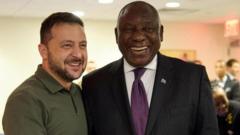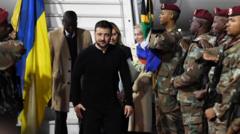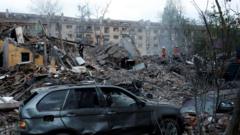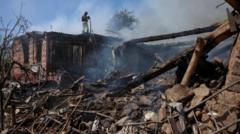A recent Russian offensive targeting Kyiv has resulted in significant casualties and intensified the ongoing conflict's volatility, coinciding with wavering international support for Ukraine's peace process.
# Deadly Airstrikes in Kyiv: Russian Assault Claims Nine Lives Amid Tenuous Peace Talks

# Deadly Airstrikes in Kyiv: Russian Assault Claims Nine Lives Amid Tenuous Peace Talks
Russian missile and drone strikes leave nine dead in Kyiv as U.S. shifts position on peace negotiations.
In the early hours of Thursday, Russian forces carried out a considerable missile and drone attack on the Ukrainian capital, Kyiv, resulting in the deaths of at least nine individuals and injuring more than 60 others, according to local officials. This strike marks one of the deadliest confrontations since last summer’s bombardment and stands as a stark reminder of the war's persistent brutality.
Witnesses reported hearing continuous explosions throughout the night as emergency workers combed through debris, searching for survivors. A two-story building housing eight apartments was severely damaged, while adjacent structures lost their windows—yet no apparent military targets were in sight. Emergency service spokeswoman Svitlana Vodolaha shared news of ongoing rescues, confirming that responders had discovered additional survivors.
Ukrainian President Volodymyr Zelensky stated that the assault involved nearly 70 missiles and 150 drones, with Kyiv sustaining the brunt of the attack. He emphasized the necessity for global recognition of the harrowing realities faced by Ukraine, taking to social media to declare his intent to return from an official visit to South Africa.
This escalation is part of a broader backdrop of sporadic violence since Russia's full-scale invasion in February 2022. The recent airstrikes recall the terrible attacks of the previous summer, notably one that obliterated a children’s hospital and caused mass casualties across Ukrainian cities—a stark contrast to the momentary cease-fire proposed by Russian President Vladimir Putin over the Easter holiday, which was viewed with skepticism.
Adding to the crisis is the shifting political landscape in the United States. Recent weeks have seen the Trump administration expressing reluctance to actively engage in peace negotiations, contradicting previous U.S. strategies toward the conflict. Reports indicate that U.S. officials are pushing Kyiv to accept an American-brokered plan favoring Russia, which Ukrainian leaders have firmly rejected.
As these tumultuous events unfold, the international community remains vigilant in assessing their ramifications, not only for Ukraine but also for the broader geopolitical dynamics at play.
Andrew E. Kramer and Oleksandra Mykolyshyn contributed to this report, with Kim Barker providing in-depth coverage of the situation in Ukraine, reflecting the ongoing strife and its implications.
Witnesses reported hearing continuous explosions throughout the night as emergency workers combed through debris, searching for survivors. A two-story building housing eight apartments was severely damaged, while adjacent structures lost their windows—yet no apparent military targets were in sight. Emergency service spokeswoman Svitlana Vodolaha shared news of ongoing rescues, confirming that responders had discovered additional survivors.
Ukrainian President Volodymyr Zelensky stated that the assault involved nearly 70 missiles and 150 drones, with Kyiv sustaining the brunt of the attack. He emphasized the necessity for global recognition of the harrowing realities faced by Ukraine, taking to social media to declare his intent to return from an official visit to South Africa.
This escalation is part of a broader backdrop of sporadic violence since Russia's full-scale invasion in February 2022. The recent airstrikes recall the terrible attacks of the previous summer, notably one that obliterated a children’s hospital and caused mass casualties across Ukrainian cities—a stark contrast to the momentary cease-fire proposed by Russian President Vladimir Putin over the Easter holiday, which was viewed with skepticism.
Adding to the crisis is the shifting political landscape in the United States. Recent weeks have seen the Trump administration expressing reluctance to actively engage in peace negotiations, contradicting previous U.S. strategies toward the conflict. Reports indicate that U.S. officials are pushing Kyiv to accept an American-brokered plan favoring Russia, which Ukrainian leaders have firmly rejected.
As these tumultuous events unfold, the international community remains vigilant in assessing their ramifications, not only for Ukraine but also for the broader geopolitical dynamics at play.
Andrew E. Kramer and Oleksandra Mykolyshyn contributed to this report, with Kim Barker providing in-depth coverage of the situation in Ukraine, reflecting the ongoing strife and its implications.




















